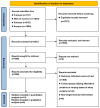Whey Protein Supplementation Combined with Exercise on Muscle Protein Synthesis and the AKT/mTOR Pathway in Healthy Adults: A Systematic Review and Meta-Analysis
- PMID: 40871607
- PMCID: PMC12389377
- DOI: 10.3390/nu17162579
Whey Protein Supplementation Combined with Exercise on Muscle Protein Synthesis and the AKT/mTOR Pathway in Healthy Adults: A Systematic Review and Meta-Analysis
Abstract
Background: The process of muscle protein synthesis (MPS) plays a pivotal role in the enhancement of muscle function. Following a bout of exercise, the rate of MPS experiences an elevation for a brief period, known as the "anabolic window." Despite whey protein supplementation has been demonstrated to augment the post-exercise anabolic window, the optimal timing and dosage remain controversial. Therefore, the present systematic review and meta-analysis were conducted to evaluate the effects of whey protein supplementation on post-exercise MPS and its protein kinase B (AKT)/mammalian target of the rapamycin (mTOR) pathway in healthy adults. Methods: Following PRISMA guidelines, this review included 21 RCTs, with 15 studies subjected to meta-analysis and 6 studies to qualitative analysis. Eligible studies examined myofibrillar fractional synthetic rate (FSR) or the AKT/mTOR pathway-related protein phosphorylation levels in muscle biopsy samples. Results: The combination of whey protein supplementation and exercise has been shown to significantly enhance FSR (Hedge's g = 1.24, 95% CI: 0.71-1.77; p < 0.001), with increases ranging from 1.3 to 1.6 folds when consumed immediately after exercise and up to 2.5 folds when given 45 min prior to multiple-set resistance exercise. A dose-dependent increase in FSR was observed in response to whey protein supplementation, ranging from 10 to 60 g. In comparison to the placebo group, whey protein supplementation enhanced the phosphorylation levels of AKT, mTOR, eukaryotic translation initiation factor 4E-binding protein-1 (4E-BP1), 70 kDa ribosomal protein S6 kinase (p70S6K), and ribosomal protein S6 (rpS6) at 1-2 h post-exercise. Phosphorylation levels of p70S6K and rpS6 decreased 4-5 h after exercise. Conclusions: The combination of whey protein supplementation and exercise improves MPS in a time- and dose-dependent manner. Consumption of 20-40g of whey protein before multiple sets of resistance exercise may enhance myofibrillar FSR and activate the AKT/mTOR pathway, thereby augmenting MPS and extending the anabolic window.
Keywords: AKT; exercise; mTOR; muscle protein synthesis; whey protein.
Conflict of interest statement
The authors declare no conflicts of interest.
Figures









References
Publication types
MeSH terms
Substances
Grants and funding
LinkOut - more resources
Full Text Sources
Medical
Research Materials
Miscellaneous

